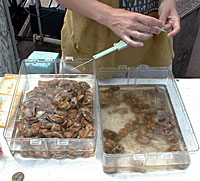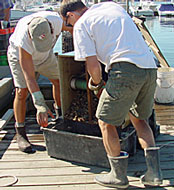 | ||||||
 |
Policy and ManagementAquacultureAquaculture is the farming of aquatic plants and organisms. It is a form of agriculture where organisms are breed in artificial or semi-artificial aquatic conditions. Many aquatic animals and plants are cultured for commercial reasons, while others are grown for research or demonstration. Some examples of aquaculture are seaweed cultured for food and additives, plants cultured for gardens or food, fish cultured for food, aquariums, or bait fish, and shellfish cultured for shells, food, or even pearls. In artificial settings, aquaculturists must control the water quality. First an artificial tank or holding pond must be created, then filled with sea-like water, with the correct salinity, pH, and temperature. Organisms must then be grown, harvested and removed from the tank or pond. 
Oysters being measured (Courtesy of Jennifer Mugg) (Click for larger image) Fish can also be raised in cages or raceways. Raceways are long, narrow ponds that receive a continuous flow of water. Cages or nets can be filled with juvenile organisms and then lowered into the water and grown in these enclosed spaces. Shellfish, plants, and other organisms that attach to a substrate, can be placed in breeding beds and monitored in a particular area. Another way to raise these organisms is to attach them to ropes or poles and suspend them into the water from rafts or buoys. Buoys are also used to mark breeding cages and beds. 
Oyster Aquaculture (Click for larger image) With a decline in commercial fisheries of New England, aquaculture can supplement the growing demand of seafood. Many other countries in Asia and Europe already have extensive aquaculture methods and production because the stocks in these areas were depleted long ago. Global aquaculture production now accounts for almost 20% of total seafood production. In Narragansett Bay aquaculture is comprised mainly of shellfish production (primarily oysters, but also quahogs and mussels). In 2000, 30 acres were used in the Bay for oyster and quahog production. Currently (as of December 2001) 53 acres are used for oysters, quahogs and mussels. There are 18 aquaculture farms in Rhode Island and in the past year aquaculture and related industries brought in a revenue of $5,364,977. The University of Rhode Island and Roger Williams University play a large role in the aquaculture industry through research and education. The aquaculture industry in Rhode Island is continuously growing and new permits are being made to increase aquaculture. The Coastal Resources Management Council, CRMC, is currently working on a project to map the Bay and the sites used for aquaculture. Rhode Island also held the 5th Annual Rhode Island Aquaculture Conference in 2001 in conjunction with the 1st Annual Southern New England Aquaculture Conference.
|
|||||